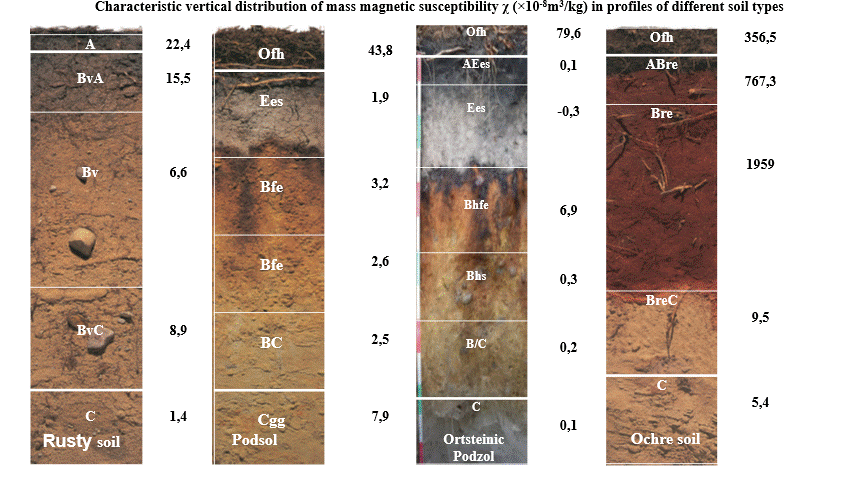Recently soil magnetometry has been proposed as an emerging technique for detecting and determining potential soil pollution. The problem of separating the anthropogenic magnetic signal from its natural background is a key issue. For this purpose the knowledge on the distribution of magnetic signal in different types of soil profiles has a crucial importance. Magnetic properties of soils have been used widely in assessing topsoil pollution, soil degradation and erosion, history of land use, reclamation/recultivation, etc. This research is mostly facilitated by highly sensitive and fast measurements of magnetic susceptibility. The efficacy of the method used for pollution study is usually based on magnetically enhanced shallow layer due to atmospherically deposited iron-oxide particles, which occurs usually on the boundary between organic horizon (mostly humus layer) and mineral (mostly illuvial) horizons. In soils with well-developed soil profile this effect is observed in depths to about 10 cm. In the case of highly-permeable soils with low content of humus a high dynamics of migration of magnetic particles can be expected. In such case a significant mixing of particles of anthropogenic and natural origin may be observed.
The main research hypothesis assumes that iron oxides in soils are of different origin, including lithogenic, anthropogenic and pedogenic contribution. Environmental-magnetic methods provide information on composition, concentration, and relative grain-size distribution of iron oxides. This project focuses on soils mostly located in forest areas, with weakly developed (or lack of) humus layer, high permeability and specific arrangement of soil horizons in the profile. Thus, contrary to other common soil types, no distinct, well pronounced magnetically enhanced layer is expected to occur on the bottom of humus horizon. In the case of initial soils such as Podzols, Arenosols, Cambisols or Regosols, we assume that atmospherically deposited anthropogenic iron oxides can migrate in the soil profile further down and reach the mineral horizons in significant amounts. In such situation, their magnetic properties may significantly change, which can be an indication of pollution by other substances including potentially toxic elements.
The project aims at developing new geophysical tool, based on soil magnetism, which can be applied in soil taxonomy for identification of diagnostic horizons. The reliability, accuracy and applicability of magnetic properties for soil taxonomy and identification of certain diagnostic parameters will be assessed using statistical and geostatistical methods.
We expect to answer the question if downward migration (to mineral horizons) of ferrimagnetic particles of anthropogenic origin is possible in soils with relatively high permeability, which causes mixing of natural and anthropogenic particles. We expect to identify different sources of magnetic particles in the soils (e.g. lithogenic, pedogenic and anthropogenic) by using a combination of various magnetic parameters together with an advanced geostatistical analyses. We also expect to develop new tool for faster and cheaper identification of diagnostic soil horizons, which will be useful in soil taxonomy of soil types, in which iron minerals plays the crucial role.







